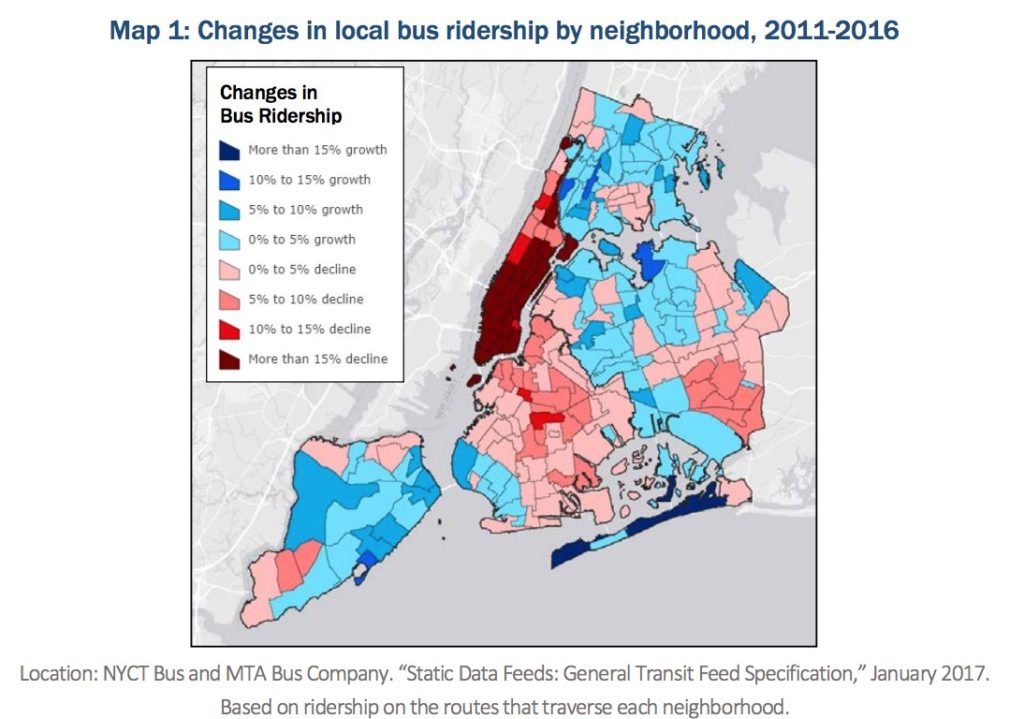On Tuesday, New York City Comptroller Scott M. Stringer released a report focused on how to improve the NYC bus system. In the 60-pages of Comptroller Stringer’s report, 19 recommendations on how to improve the efficiency, reliability, and ridership of the NYC bus system are offered. Ranging from route redistribution to bus lane enforcement, the recommendations aim to help New York City and MTA reduce commute times, improve access to good paying jobs, alleviate gaps in the subway system, ease subway overcrowding, and connect underserved areas of the City.
New York City is home to over 8.5 million people, including 4.4 million who commute to work each day. A very large percentage of these people commute on some form of public transportation including subways, ferries, commuter rails, and buses. However, NYC’s form of transportation with the greatest reach is by far the bus system. In 2016, the MTA’s 5,700 buses picked-up 760 million passengers at 15,400 stops along 330 routes in every corner of the five boroughs.
Comptroller Stringer’s report shows the juxtaposition between the reach and ridership of the NYC bus system and the MTA’s negligence of it. With its extraordinary size, reach, and ridership, one would expect the NYC bus system to be top notch in all ways, however, due to MTA’s focus on the subway system, it has been suffering and in return adversely affecting its riders.
As a result of the underperformance of NYC buses, it is not a surprise that buses have lost 100 million riders over the last 8 years. Slow and inefficient routes, infrequent stops, crowded bus lanes, nonexistent bus shelters and poorly marked bus stops; these problems are the result of the MTA’s undivided focus on the NYC subway system and the reasons New Yorkers choose other forms of transportation. Approximately 24 percent of Brooklyn and Manhattan local buses, 23 percent of Bronx buses, 21 percent of Queens buses, 19 percent of Staten Island buses, and 18 percent of inter-borough express buses fail to maintain scheduled spacing during the day. The buses are also slow, especially in Manhattan where average bus speeds are only 5.5mph.
Comptroller Stringer’s report seeks to solve the issues plaguing the bus system but also points to demographic issues that accompany the systems’ budget disparity. Falling bus ridership in many Manhattan and Brooklyn Communities is occurring simultaneously with gentrification, where lower income communities and communities of color are displaced by higher rents and residents who rely on subways to commute to higher income jobs in Manhattan. The report makes evident the bus system’s failure to plan routes to accommodate people who have been displaced.
Bus commuters, 75 percent being people of color, are the most economically vulnerable residents of New York City, with less income and less education than both subway commuters and city residents. Below is Map 1 from the Comptroller’s report which can be found on page 18. The map shows the areas of NYC with the highest loss of bus riders—most affected being gentrified areas of Brooklyn such as Williamsburg, and the majority of Manhattan.

When compared to ethnographic maps of New York City, this map confirms that white areas of the City, including Manhattan and Williamsburg, are losing bus riders exponentially more than more diverse areas of the city. This is largely due to the fact that the subways in Manhattan and North Brooklyn are more prevalent, connecting residents easily to jobs, restaurants, stores, and other places.
Conversely, residents in South Brooklyn, the Bronx, and Queens do not have it as easy. As shown in the blue of Map 1, areas experiencing bus ridership growth are those that are least served by the subway. With less subway lines and more distance between stops and residents’ homes, they must rely on the bus system to get them around. According to Comptroller Stringer’s report, NYC buses are becoming increasingly inadequate, leaving areas experiencing bus ridership growth at a loss.
Comptroller Stringer’s report makes suggestions to the MTA to make New York a city for all of its residents. By suggesting solutions to the decline of bus ridership, including route changes, more frequent and maintained bus stops, and better used bus lanes, the report is paving way for city-wide progress for public transportation, thus improving the lives of all New Yorkers, especially those outside of Manhattan.
A full PDF of the report can be found here.
